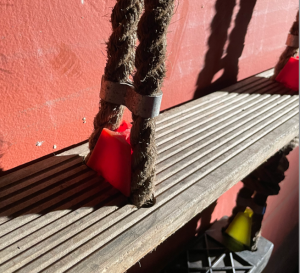The Charity
Aviation
Maritime
M2308

Initial Report
The reporter stated that a pilot ladder had to be condemned as it was unsafe for use. It had very loose steps, which is typical of a certain manufacturer whose ladders seem to have a serious design flaw. The matter has been raised to the port authority.
CHIRP Comment
There is a notable issue with the manufacture and design of pilot ladders, particularly regarding the stability of the steps. A common problem arises with the clamping mechanism used to secure the chocks, if it is not robust enough to ensure that the ladder steps remain horizontal throughout the ladder’s working life.
Some pilot ladders have good clamping and are constructed in accordance to ISO799, and some manufacturers have clamps that come loose at 300k force (where 880k is mandatory as per ISO799).
Regarding the steps, IMO A.1045 states in 2.1.2.7: they should be secured in such a manner that each will remain horizontal. If rope is used to secure the steps to keep them horizontal the correct type of rope to assemble a ladder is three-ply tarred marlin of minimum breaking strength of 800N (ISO799-1:2019 rule 4.7)
On a related note, using shackles to secure the ladder damages clamping mechanisms and makes the steps become loose. Shackles must not be used. Pilot ladders shall only be secured at intermediate lengths by a device designed by the manufacturer for that purpose, or a rolling hitch. No other method is acceptable.
CHIRP wishes to remind readers that pilot transfers are high-risk operations. It is crucial for crew members to maintain heightened safety awareness to ensure that the transfer from the pilot boat to the bridge is conducted as safely as possible.
To address this safety concern, CHIRP recommends developing a standardized securing arrangement for pilot ladders, approved by pilots, to ensure step stability. It encourages collaboration among manufacturers to create a common design that improves ladder safety.
Additionally, it is essential for companies to assess their crews’ understanding of pilot transfer arrangements. These assessments can be conducted during internal audits, safety inspections, and visits to the vessel by the Designated Person Ashore (DPA). Regular evaluations will help ensure crews are adequately trained and that safety protocols are consistently followed
Key Issues relating to this report
Design- Clearly, there are flaws in the design. This is borne out by the number of times that pilots are seeing the same issue. How do you assess the quality of the pilot ladder when one is procured by the company? Do you have any input in the procurement process?
Capability- Pilot Transfer Arrangement (PTA) knowledge and safety can easily be assessed by management. Does your company have a process for ensuring that the crew have the necessary knowledge? Does your company carry out training for PTA?







